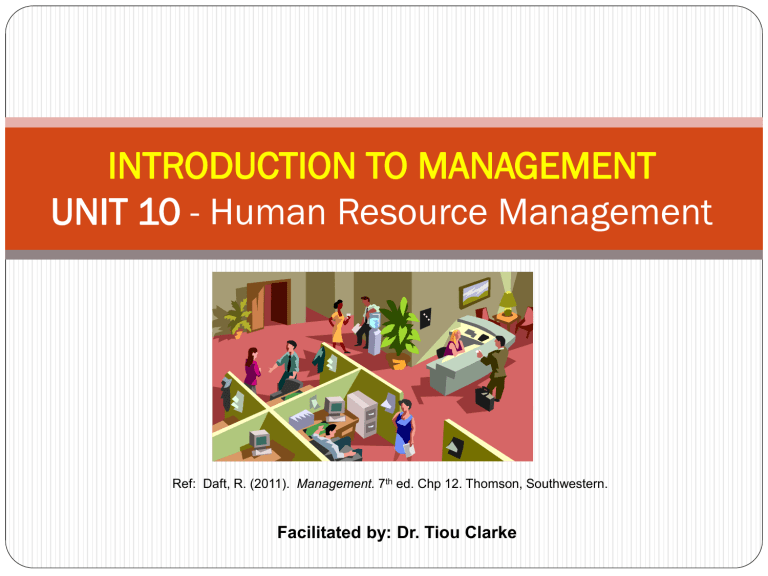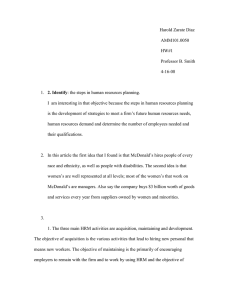
INTRODUCTION TO MANAGEMENT UNIT 10 - Human Resource Management Ref: Daft, R. (2011). Management. 7th ed. Chp 12. Thomson, Southwestern. Facilitated by: Dr. Tiou Clarke UNIT OBJECTIVES At the end of this unit students should be able to: Explain the role of human resource management in organizational strategic planning. Relate legislations and societal trends that influence human resource management. The goals of Human Resource Management Differentiate the various means human resource managers use to meet their goals 2 Slides compiled by: Flo Angus UNIT CONTENT Human resource management and organizational strategic 3 planning Local and global legislations Human resources environmental forces Changes in the field of human resource management Recruitment and selection tools Attracting, developing and maintaining an effective workforce The Strategic Role of Human Resource Management Human Resource management has shed its old personnel image and gained recognition as a vital player in corporate strategy HRM departments not only support the organization’s strategic objective but actively pursue an ongoing, integrated plan for furthering the organization’s performance ●Higher employee productivity ●Stronger financial results ●Achieve organization’s strategic goals ●Key players on management team Manager’s Challenge: UPS Buffalo, New York 4 Current Strategy Issues Current strategy issues of interest to managers include: Becoming more competitive on a global basis Improving quality, productivity, and customer service Managing mergers and acquisitions Applying new information technology for e-business Operating in a completely virtual space Accessing international talents without the border and regulation restrictions. 5 5 Issues /Factors Affecting the Entire Organization 6 Globalization Changing Technology Shift to knowledge work Rapid shifts in markets and the external environment Societal trends Government Regulations Changes in organizational culture Structure Strategy and goals Virtual workspace and CRMs Tools for Putting Strategy into Action Environment Strategy 7 Organization • • • Leadership Use persuasion Motivation Shape culture / values Structural Design • Design organization chart • Create teams • Determine centralization/ Decentralization • Arrange facilities, task design Human Resources • Recruit/ select employees • Manage transfers, promotions/ training • Direct layoffs/ recalls Information and Control Systems • Revise pay, reward system • Change budget allocations • Implement information systems • Apply rules/procedures P E R F O R M A N C E Human Resource Management in Strategic Planning Strategy implementation - putting strategy into action. Tools for Implementation: Leadership Structural design Information and Control Systems HUMAN RESOURCES/HUMAN CAPITAL. 8 Three Ways HR Is Changing 1 Focus on building human capital 2 3The use of information technology 9 Development of global HR strategies IHRM Human Capital - IHRM Human Capital = economic value of the knowledge, experience, skills, and capabilities of employees IHRM = addresses the complexity that results from recruiting, selecting, developing, and maintaining a diverse workforce on a global scale 10 Information Technology Human resource information technology = an integrated computer system designed to provide data and information used in HR planning and decision making Traditional HR to e-HR significantly affected every area of human resource management Some organizations are close to a paperless HRM system – saves time, money, frees staff 11 Elements of Human Resource Management All managers are resource managers Employees are viewed as assets Matching process, integrating the organization’s goals with employees’ needs How a company manages its workforce may be single more important factor in sustained competitive success 12 Local Labour Legislations Primary purpose to protect the workers against unfair treatment, examples; Minimum Wage Act, 1938, last amendment in 2011 Factory Act (Occupational Safety and Health Act) Equal Pay (for Men and Women) Act 1975 Maternity Leave Act Employment (Termination and Redundancy) Payments Act Labour Relations and Industrial Disputes Act (LRIDA) (amended 2010) Occupational Health and Safety Billy – currently being tabled in Parliament 13 Human Resource Management Strategic Goals Company Strategy Attract an Effective Workforce HRM Environment Legislation Trends in society International events Changing technology HRM planning Job analysis Forecasting Recruiting Selecting Maintain an Effective Workforce Wage and salary Benefits Labor relations Terminations 14 Develop an Effective Workforce Training Development Appraisal Attracting an Effective Workforce HR Planning Retirements Growth Resignations Choose Recruiting Sources Want Ads Headhunters Internet Company’s Needs Strategic goals Current and future competencies Market changes Employee turnover Corporate culture 15 Company Inducements Pay and benefits Meaningful work Advancement Training Challenge Select the Candidate Application Interview Tests Matching Model Match With Matching Model Match With Welcome New Employee Employee Contributions Ability Education & experience Creativity Commitment Expertise Employee’s Needs Stage of career Personal values Promotion aspirations Outside interests Family concerns Human Resource Planning Forecasting of human resource needs and the projected matching of individuals with expected vacancies ● ? = New technologies emerging ● ? = Volume of business likely next 5-10 years ● ? = Turnover rate, how much is avoidable, if any Matching Model An employee selection approach in which the organization and the applicant attempt to match each other’s needs, interests, and values 16 Recruiting Recruiting involves those activities or practices that define the desired characteristics of applicants for specific jobs ● Internal – promote-from-within policies used by many to fill high- level positions • It is less costly than external search • Generates higher employee commitment, development and satisfaction because it offers opportunities for career advancement to employees rather than outsiders. ● External = recruiting newcomers from outside has advantage of multiple sources ● E-cruiting = use of Internet - fastest-growing approach to recruiting ● Caribbeanjobs.com, Indeed, etc. 17 Sources of Recruits Advertising State (government) Employment services Private employment agencies (headhunters) Job fairs or Recruitment Drive Employee referrals 18 Assessing Organizational Needs Basic building blocks of HRM include: Job Analysis Job Description Job Specification 19 Job Analysis Job Analysis is the systematic process of gathering and interpreting information about the essential duties, tasks, and responsibilities of a job, as well as about the context within which the job is performed. 1. • • 20 Job analysis helps organizations recruit the right kind of people and match them to appropriate jobs. To perform job analysis, managers or specialists ask about work activities and workflow, the degree of supervision given and received in the job, knowledge and skills needed, performance standards, working conditions, and so forth. Realistic Job Previews Job Analysis helps enhance recruiting effectiveness by enabling the creation of realistic job previews. A Realistic Job Preview is a recruiting approach that gives applicants all pertinent and realistic information about the job and the organization. 21 Job Descriptions & Specifications After the job analysis is done, a job description is prepared. The job description is a clear and concise summary of the specific tasks, duties and responsibilities. The job specification outlines the knowledge, skills, education, physical abilities and other characteristics needed to adequately perform the job. 22 Selection Selection is the process of determining the skills, abilities, and other attributes a person needs to perform a particular job. In the selection process, employers assess applicants’ characteristics to determine the “best fit” between the job and applicant characteristics. 23 Application Form The application form is used to collect information about the applicant’s education, previous job experience and other background characteristics. 24 The Interview The interview serves as a 2-way communication channel that allows both the organization and the applicant to collect information that would otherwise be difficult to obtain. Panel interviews – candidate meets with several interviewers who take turns asking questions – increases interview validity Computer-based interviews - complement traditional interviewing information 25 Inappropriate or Illegal Questions (USA) Employment Applications and Interviews 26 Race-related questions Age Religion Gender National origin Marital/family status Testing and Assessment Employment Test = written or computer-based test designed to measure a particular attribute such as intelligence or aptitude Assessment Center = technique for selecting individuals with high managerial potential based on their performances on a series of simulated managerial tasks 27 Assessment Center Assessment centers present a series of managerial situations to groups of applicants, over, say, two ot threeday period. One technique is the in-basket simulation, which requires the applicant to play the role of a manager who must decide how to respond to ten memos in his or her inbasket within a 2-hour period. Panels of 2 or 3 trained judges observe the applicant’s decisions and assess the extent to which they reflect interpersonal, communication and problem-solving skills. 28 Developing an Effective Workforce Training and Development represent a planned effort by an organization to facilitate employees’ learning of jobrelated skills and behaviors. Organizations spend nearly $100 billion each year on training. 29 Types of Training On-the-job Training, where an experienced employee is asked to take a new employee “under his or her wing” and show the newcomer how to perform job duties. Moving people to various types of jobs within the organization, where they work with experienced employees to learn different tasks – cross-training Advantages of OJT include: Few out of pocket costs for training facilities, materials or instructor fees Easy transfer of learning back to the job Fastest and most effective means of facilitating learning in the workplace. 30 Types of Training Mentoring Orientation Training Classroom Training Self-Directed Learning Computer-based Training 31 Corporate Universities Corporate University is an in-house training and education facility that offers broad-based learning opportunities for employees – and frequently for customers, suppliers and strategic partners as well – throughout their careers. 32 Promotion from Within Another way to further employee development is through promotion-from-within, which can help companies retain valuable employees. This provides challenging assignments, prescribes new responsibilities, and helps employees grow by expanding and developing their abilities. 33 Performance Appraisal Performance Appraisal is the process of observing and evaluating an employee’s performance, recording the assessment, and providing feedback to the employee 34 Maintaining an Effective Workforce Compensation Wage and Salary Systems Pay for Performance Benefits Vacation, other leaves Education grants, etc. Termination Ethical Dilemma: A Conflict of Responsibilities 35 Compensation Compensation refers to: All monetary payments All goods or commodities used in lieu of money to reward employees An organization’s compensation structure includes wages and/or salaries and benefits such as health, insurance, paid vacations, or employee fitness centers. 36 Benefits Health insurance Vacation Subsidized lunch Subsidized utilities On-site gym Uniforms Day-care centres for children of staff Pension contributions 37 Termination Some will retire, others will depart voluntarily for other jobs, and still others will be forced out through mergers and cutbacks or for poor performance. The value of termination for maintaining an effective workforce is twofold: 1. 2. 38 Employees who are poor performers can be dismissed. Productive employees often resent disruptive, lowperforming employees who are allowed to stay with the company and receive pay and benefits comparable to theirs. Employers can use exit interviews as a valuable HR tool, regardless of whether the employee leaves voluntarily or is forced out. Exit Interview An exit interview is an interview conducted with departing employees to determine why they are leaving. The value of the exit interview is to provide an excellent and inexpensive way to learn about pockets of dissatisfaction within the organization and hence reduce future turnover. 39 EL FIN! 40




